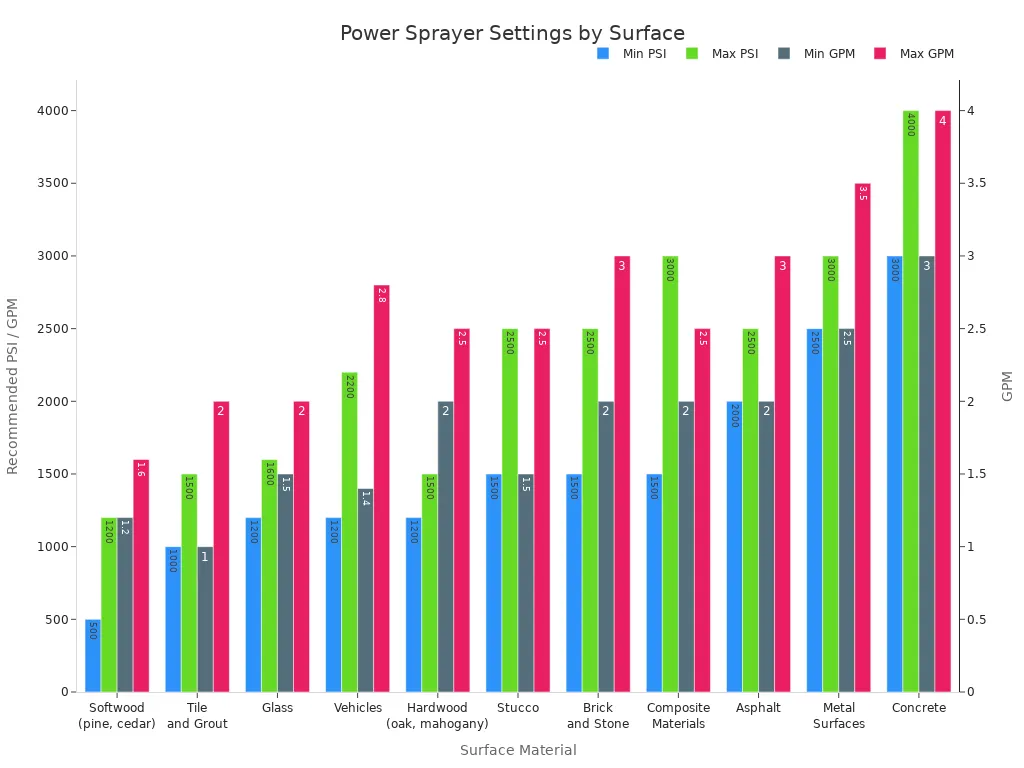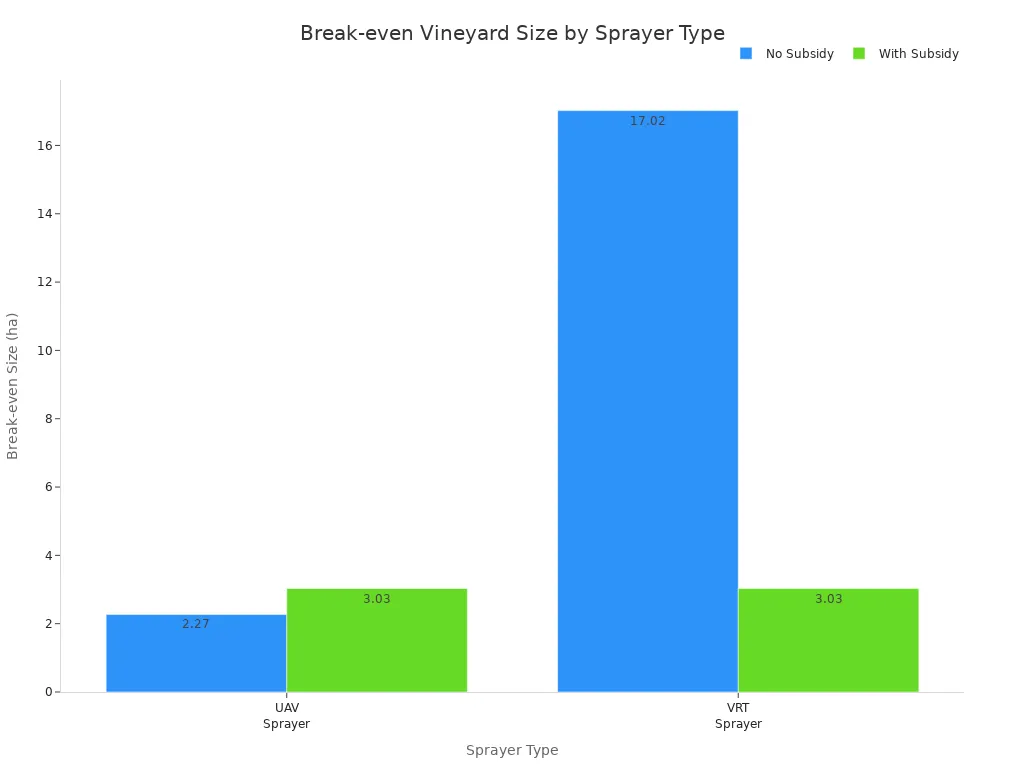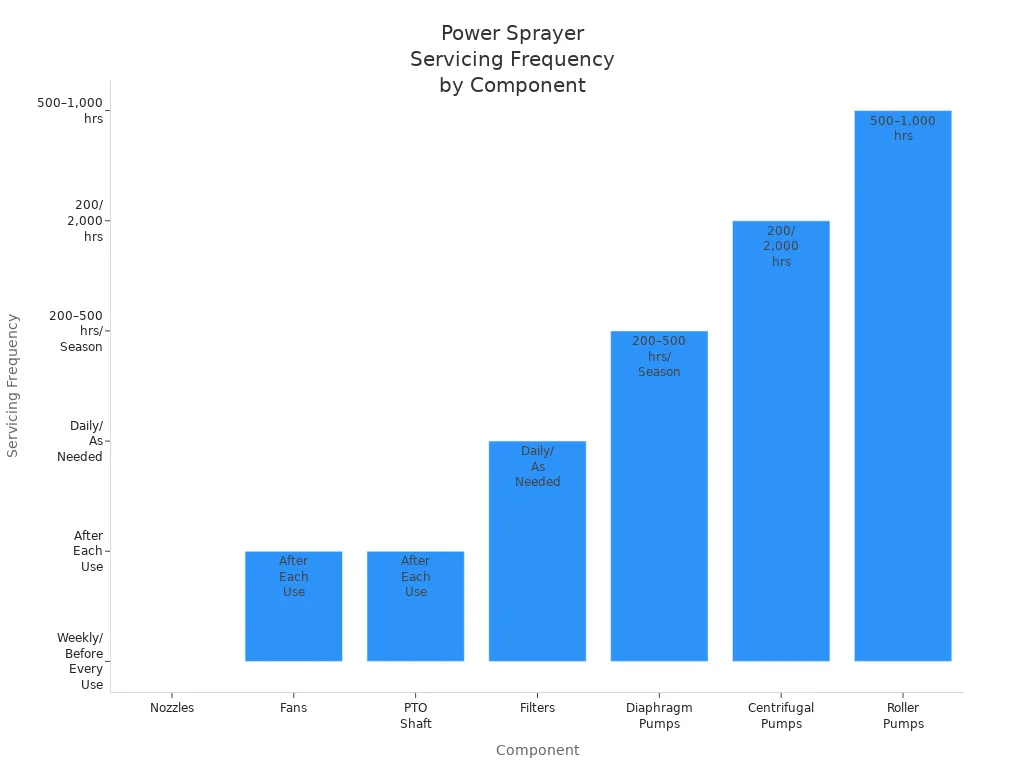A power sprayer lets you put liquids on things fast and evenly. You can use it for many tasks. You can spray pesticides on crops. You can clean big areas. You can help your garden stay healthy. Some common uses are:
Treating crops with fertilizers or chemicals to help them grow
Cleaning equipment or buildings in factories and warehouses
Controlling pests in homes, gardens, and public places
Taking care of lawns and landscapes in your yard
A power sprayer saves you time. It helps you get good results in many jobs.
Key Takeaways
Power sprayers let you spray liquids fast and evenly. People use them for farming, cleaning, pest control, and disinfection. Using a power sprayer saves time and work. It is much faster than spraying by hand. You can cover big areas quickly. You can change the spray type and pressure for each job. This helps you use less chemicals and get better results. Always wear the right safety gear. Check your sprayer before you use it. This keeps you and the environment safe. Clean and take care of your power sprayer often. This helps it work well and last longer.
Power Sprayer Applications
Agriculture
A power sprayer helps protect and feed crops. Farmers use these machines for pesticides, herbicides, fertilizers, and fungicides. This keeps plants healthy and helps crops grow more. Farms use different sprayers for different jobs. Boom sprayers cover big fields. Drone sprayers reach places that are hard to get to. Some new sprayers have sensors. These sensors spray only where needed. This saves chemicals and helps the environment. Using a power sprayer helps crops grow better. It also saves time and money.
Here is a table showing common types of power sprayers used in agriculture and their advantages:
Type of Power Sprayer | Common Agricultural Uses | Advantages |
Tractor-Mounted Sprayers | Medium to large farms, row crops like corn, soybeans, wheat | Large tank capacity, wide boom arms for broad coverage, GPS integration for precision, efficient chemical use |
Power Sprayers (Motorized) | Medium-sized farms, orchards, hilly terrains | Portable, powerful spraying pressure, covers more area than manual sprayers, suitable for tree spraying |
Boom Sprayers | Medium to large flat fields, cereal crops, oilseeds | Uniform chemical distribution, adjustable boom width/height, high flow rates, reduces worker exposure |
Aerial Sprayers (Drones) | Large commercial farms, rice paddies, inaccessible or irregular terrain | Rapid application over large areas, minimal soil compaction, GPS-guided automated routes, labor-saving technology |
Airblast Sprayers | Orchards, vineyards, dense foliage crops | Powerful air streams for thorough coverage, precise application with less liquid, reduces labor, adjustable airflow and nozzles |
Mist Blower Sprayers | Orchards, perennial crops, greenhouses | Fine mist coverage with reduced liquid use, effective for pesticides/fungicides, portable or tractor-mounted, minimizes chemical drift |
Self-Propelled Sprayers | Large commercial farms | High operational speed, automated steering, variable rate controls, precise coverage, reduces soil compaction |
High-Pressure Power Sprayers | Specialized applications, greenhouses | Deliver fine droplets at high pressure, efficient for vertical surfaces and finishing applications |
Low-Volume Power Sprayers | Environmentally sensitive areas | Minimize chemical usage while maintaining effectiveness, reduce environmental impact |
Tip: Picking the right power sprayer can save money and help the environment.
Pest Control
A power sprayer helps control pests in homes, gardens, and public places. You can use it to get rid of many bugs and insects. Some pests you can treat with a power sprayer are:
Ants (carpenter, pavement, odorous house, fire ants)
Spiders (house spiders, dangerous species)
Cockroaches (German, American, Oriental, smokybrown)
Beetles (carpet beetles, wood-boring beetles)
Crickets (house and camel)
Earwigs
Silverfish
Millipedes and centipedes
Wasps and hornets
Flies and gnats
Stink bugs
Boxelder bugs
Lady beetles
Mosquitoes
Many other crawling and flying insects
You can use portable or mounted sprayers for pest control. Studies show power sprayers with electrostatic technology use less water and pesticide. They cover more space and reach hidden spots. This makes pest control easier and better.
Cleaning
A power sprayer cleans many surfaces fast and well. At home, you can clean siding, decks, patios, driveways, and fences. In factories or warehouses, you can clean equipment, floors, and building exteriors. Power sprayers use strong water pressure to remove dirt, oil, mold, and stains. These stains are hard to clean by hand.
Here is a chart showing the recommended pressure and water flow for cleaning different surfaces:
Note: Always use the right pressure for the surface you clean. This helps you avoid damage.
Power sprayers clean faster and deeper than regular tools. They reach cracks and rough spots. They remove tough stains and use less water and soap. This makes them a good choice for home and work cleaning.
Disinfection
A power sprayer can disinfect surfaces in hospitals, schools, food factories, and public places. Electrostatic sprayers charge the disinfectant. This makes a fine mist that sticks to surfaces, even in hard spots. This kills germs and viruses better than wiping by hand.
Studies show electrostatic power sprayers cover surfaces evenly. They also use less disinfectant. These sprayers help keep places safe from bacteria and viruses, like COVID-19. You can use handheld sprayers for small areas. Backpack and mounted sprayers work for bigger spaces. These tools save time, cut down on chemical waste, and help keep things clean.
Power Sprayer Benefits
Efficiency
A power sprayer helps you finish work much faster. Manual sprayers need you to pump by hand. This can make you tired and takes a long time. Power sprayers use motors or batteries instead. You do not have to pump them yourself. You can spray big areas in a short time. This is helpful when you are busy, like during planting or harvest. Many new sprayers have GPS and automatic controls. These features help you work quicker and with less effort.
Power sprayers stop you from having to pump by hand. This means you do not get as tired.
You can spray many acres in just a few hours.
Automatic spraying lets you do other jobs at the same time.
Farms and companies save money because they need fewer workers.
A study found that battery-powered sprayers last for hours. They can cover large fields without stopping. This makes them great for medium and big farms. The table below shows how different sprayers save money for large farms:
Sprayer Type | Break-even Vineyard Size (ha) | Effect of Subsidies | Key Cost Factors | Managerial/Policy Insights |
UAV Sprayer | 2.27 ha (without subsidies) | Subsidies lower to ~3.03 ha | Lower purchase price, higher working efficiency, fixed costs include georeferencing, insurance, licenses | Most cost-effective for farms >2.27 ha; best option regardless of vineyard size with subsidies; regulatory changes needed for adoption |
VRT Sprayer | 17.02 ha (without subsidies) | Subsidies lower to ~3.03 ha | Higher equipment cost, sensitive to purchase price and pesticide costs | Economically viable for large farms; subsidies can enable adoption by smaller farms; high investment cost is a barrier |
Conventional | N/A | N/A | Higher pesticide application rates and labor costs | Less cost-effective compared to PAS technologies |
Using a power sprayer helps you finish spraying faster and saves money over time.
Precision
A power sprayer lets you control how you spray liquids. You can change the nozzle and pressure for each job. This means you can spray a gentle mist on soft plants. You can also use a strong spray for hard surfaces. These settings help you use less chemicals and make sure every spot gets covered.
You can change the nozzle to make the spray bigger or smaller.
You can reach places that are hard to get to, like under leaves.
The pressure stays the same, so you do not miss any spots.
New sprayers have comfy handles and straps for easy use.
Electrostatic sprayers give the spray a special charge. This helps the spray stick to all sides of a surface. The EPA says this covers up to three times more area than normal spraying. Studies show UAV sprayers cover crops more evenly than ground sprayers, especially in tall plants.
Versatility
You can use a power sprayer for many jobs. On farms, you spray pesticides, herbicides, and fertilizers. In landscaping, you water plants and clean patios. For cleaning, you wash dirt off cars, buildings, and tools. You can also use power sprayers to disinfect schools, hospitals, and public places.
Power sprayers work with many liquids, like water, chemicals, and disinfectants.
You can change the spray for different jobs and surfaces.
Small sprayers help you reach tight or high spots.
Safety parts and easy cleaning make them good for daily use.
A power sprayer is a handy tool that helps you work faster, more carefully, and in many ways.
Safety and Maintenance
Safe Operation
It is very important to stay safe when using sprayers. Chemicals can hurt your skin, eyes, or lungs. The equipment can leak or break. You should follow these steps to keep everyone safe:
Wear the right personal protective equipment (PPE). Use gloves that protect against chemicals. Wear goggles or a face shield. Put on long sleeves and strong boots. Use a respirator if you spray where air does not move well.
Look at your sprayer before you use it. Check hoses, nozzles, and tanks for leaks or damage. Make sure every part works right.
Mix chemicals where there is fresh air. Do not eat, drink, or smoke when you handle chemicals.
Set your sprayer to use the right amount. Too much chemical can hurt plants, people, and nature.
Only spray when the weather is calm. Wind can blow chemicals where you do not want them.
Stay away from water sources when spraying. This keeps water clean.
Clean your sprayer after you use it. This removes leftover chemicals and keeps your sprayer ready.
Store chemicals and sprayers in locked places with good airflow. Keep them away from kids and animals.
Always have a first aid kit close by. Know what to do if chemicals touch your skin or eyes.
Tip: Training helps you learn how to handle, mix, and spray safely. Many groups have safety classes and guides.
Maintenance Tips
Doing regular maintenance keeps your sprayer working well. It also helps stop accidents. Here are some important things to do:
Clean and check nozzles often. Clogged nozzles can make spraying uneven.
Check and clean filters to keep the flow steady. This stops blockages.
Oil moving parts like pumps and motors. This helps them last longer.
Set your sprayer often so you use the right amount of chemicals.
Charge batteries all the way and keep them in a cool, dry place.
After spraying, wash the tank and lines with clean water.
Store your sprayer in a dry, shady place. This keeps it safe from sun and dust.
Before each season, check all parts for damage or cracks. Test the sprayer with water before using chemicals.
Some parts need a professional to fix them. The table below shows how often you should service each part:
Component | Servicing Frequency | Key Maintenance Actions and Notes |
Nozzles | Weekly or before every application | Inspect spray pattern; clean gently; replace based on wear |
Fans | After each application | Check for defects; align air deflectors |
PTO Shaft | After each application | Grease spline, tubes, joints, and connections |
Filters | Daily initially, then as needed | Check and clean; replace when needed |
Diaphragm Pumps | Every 200–500 hrs or season’s end | Replace diaphragms; change oil; check air pressure |
Centrifugal Pumps | First 200 hrs, then every 2,000 hrs | Change oil; check bolts, alignment, flow, and vibration |
Roller Pumps | Every 500–1,000 hrs | Inspect and replace rollers; flush and drain after use |
Keeping good records of your maintenance helps you plan ahead and stop problems.
A power sprayer lets you do jobs faster and better. You can use it for farming, cleaning, or pest control. It covers things evenly and does not need much work from you. This is because it uses high pressure and you can change the nozzle. When you choose a sprayer, look at what powers it, what kind of nozzle it has, and how big the tank is.
Cleaning your sprayer often and using it safely helps it last longer and keeps you healthy.
FAQ
What liquids can you use in a power sprayer?
You can use water, pesticides, herbicides, fertilizers, and disinfectants in a power sprayer. Always check the sprayer manual. Some chemicals need special nozzles or tanks.
How do you choose the right nozzle for your job?
Pick a nozzle based on the liquid and the area you want to spray. Fine mist nozzles work well for soft plants. Wide spray nozzles cover large surfaces. Always match the nozzle to your task.
Can you use a power sprayer indoors?
Yes, you can use a power sprayer indoors for cleaning or disinfecting. Use low pressure and the right nozzle. Make sure the area has good airflow. Always wear safety gear.
How do you clean a power sprayer after use?
Rinse the tank with clean water. Run water through the hoses and nozzles. Remove and clean filters. Let all parts dry before storing. This keeps your sprayer working well.
What safety gear should you wear when using a power sprayer?
Wear gloves, goggles, long sleeves, and boots. Use a mask or respirator if you spray chemicals. Safety gear protects your skin, eyes, and lungs from harm.















